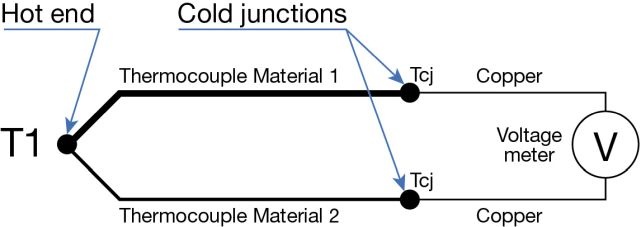Let’s look at how a thermocouple works. A thermocouple consists of two wires made of different electrical conductors that are connected together at one end (the “hot” end), that is the end you want to use to measure the temperature with.
As discovered back in 1821 by Thomas Johann Seebeck, when the connection point of these wires is taken into different temperatures, there will be a thermo-electric current generated, causing a small voltage between the wires in the open end. The voltage depends on temperature and on the materials of the conductive wires being used. This effect was named as Seebeck effect.
Simplified principle picture of a thermocouple:

In the above picture: the “Thermocouple material 1 and 2” represent the two different materials the thermocouple is made of. “T1” is the hot end of the thermocouple, i.e. the point that is used to measure temperature. The two “Tcj” are the temperatures of the cold junctions.
The above explanation is somewhat simplified, as the thermovoltage is actually generated by the temperature gradients in the thermocouple wire, all the way between the “hot” and “cold” junctions. So, it is not the junction points that actually generate the voltage, but the temperature gradient along the wire. It is easier to understand this by thinking that the thermovoltage is generated in the junctions, hot and cold ones. Maybe more scientific thermocouple theory can be provided in some other post later on, but in this one, let’s stick with the practical considerations.

















